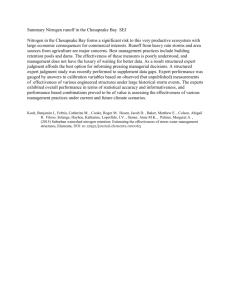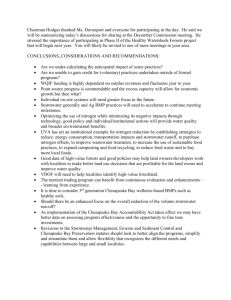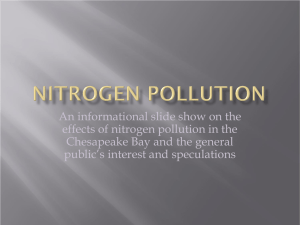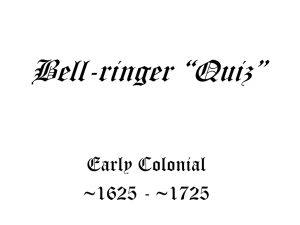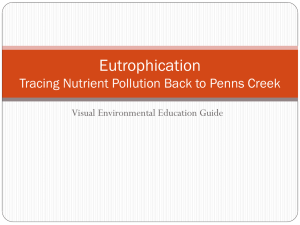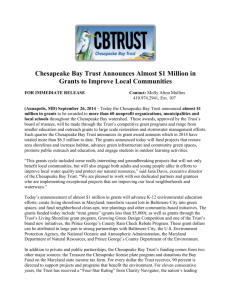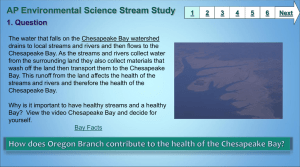Esturia - Future City Competition
advertisement
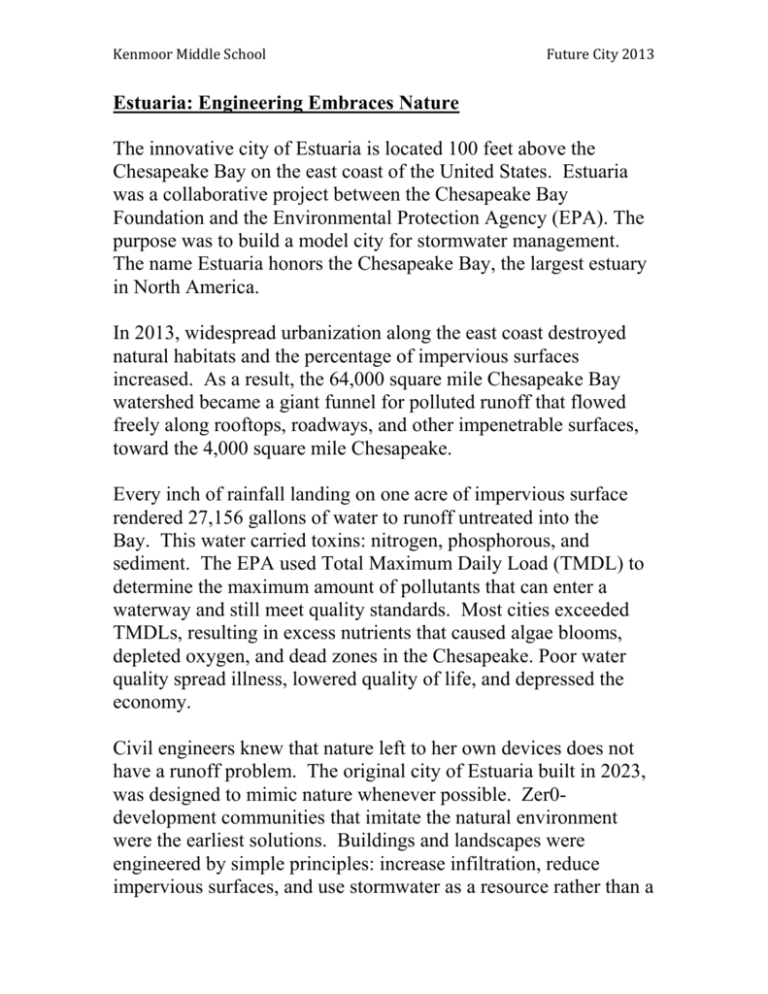
Kenmoor Middle School Future City 2013 Estuaria: Engineering Embraces Nature The innovative city of Estuaria is located 100 feet above the Chesapeake Bay on the east coast of the United States. Estuaria was a collaborative project between the Chesapeake Bay Foundation and the Environmental Protection Agency (EPA). The purpose was to build a model city for stormwater management. The name Estuaria honors the Chesapeake Bay, the largest estuary in North America. In 2013, widespread urbanization along the east coast destroyed natural habitats and the percentage of impervious surfaces increased. As a result, the 64,000 square mile Chesapeake Bay watershed became a giant funnel for polluted runoff that flowed freely along rooftops, roadways, and other impenetrable surfaces, toward the 4,000 square mile Chesapeake. Every inch of rainfall landing on one acre of impervious surface rendered 27,156 gallons of water to runoff untreated into the Bay. This water carried toxins: nitrogen, phosphorous, and sediment. The EPA used Total Maximum Daily Load (TMDL) to determine the maximum amount of pollutants that can enter a waterway and still meet quality standards. Most cities exceeded TMDLs, resulting in excess nutrients that caused algae blooms, depleted oxygen, and dead zones in the Chesapeake. Poor water quality spread illness, lowered quality of life, and depressed the economy. Civil engineers knew that nature left to her own devices does not have a runoff problem. The original city of Estuaria built in 2023, was designed to mimic nature whenever possible. Zer0development communities that imitate the natural environment were the earliest solutions. Buildings and landscapes were engineered by simple principles: increase infiltration, reduce impervious surfaces, and use stormwater as a resource rather than a Kenmoor Middle School Future City 2013 hazard. Zer0-development communities use Pre-Engineered Living Spaces (PELS) as the main residential units. PELS are as small as 12ft x 24ft x 20ft and can be linked together for multi-use buildings where people live, work, and learn. Features of PELS include: 1. Prefabrication - reducing sediment runoff from construction. 2. Lush 8" thick green roofs - planted with Sedum. Nanoreinforced wood structures support the loads. 3. Cisterns - integrated into the foundation capture excess rainwater. This water is used throughout the home. PELS have two systems, potable water for drinking, and nonpotable water for all other residential needs. Seventy percent of the Chesapeake's pollution results from runoff caused by human activity. Natural landscapes designed by landscape architects and environmental engineers are integrated into Estuaria as much as possible. Strategically placed plantings throughout the city are beautiful and functional. Estuaria’s landscapes are built on three levels: 1. Xeriscapes, or landscapes with plants that prefer dry soil are planted on natural contours. Native plants such as Switchgrass slow down and absorb rushing water, which prevents flooding in rain gardens. 2. Rain gardens with native plants preferring wet soil such as Beebalm are planted on the bottom of slopes and other low areas. These gardens infiltrate water from slopes, increase groundwater levels and prevent pollutants from entering the Bay. Kenmoor Middle School 3. Future City 2013 Managed forests with native trees are planted throughout Estuaria as buffers and landscapes. Trees benefit Estuaria in three ways: slowing water, percolating rainfall, and preventing erosion. Despite all efforts, toxins still reached the Chesapeake Bay. In 2073, chemical engineers established a pollution extraction procedure. Located just north of Estuaria, an abandoned liquid natural gas dock and storage facility was converted into a liquefied nitrogen facility. A fleet of ships was used to decontaminate Bay water through chemical reactions. First, to remove nitrogen, hydroperoxyl (HO2) is combined to form HNO2, or nitrous acid. Next, this acid is decomposed and nitrogen is used as a clean and efficient fuel. Finally, chemical engineers remove phosphorous by synthesis of hydrogen and oxygen, forming HPO4, or phosphoric acid. Similar to nitrogen it is decomposed and used to make fire retardant materials. This both reduces the volume of pollutants in the Chesapeake and uses them as resources. New industries provided jobs and the community of Estuaria grew. By 2123, PELS no longer sufficed as the primary source of housing. To minimize disruption of the restored landscape, Estuarians built upward. Skyscrapers called Eco-towers follow the same principles as the early Zer0-developed communities. These towers mimic trees as they treat and use water. They have green roofs and 4-foot deep vegetated balconies that extend from the shafts of the buildings. They perform similar to the leaves on a tree. Rainwater that reaches the parks and plazas surrounding Ecotowers is directed to foundation cisterns that act like roots of a tree. This non-potable water is then filtered, treated and pumped by wind power to holding tanks at the tops of Eco-towers, providing the required water pressure for inhabitants. To enhance the quality of life, some water is diverted for use in fountains located in urban parks and plazas. Kenmoor Middle School Future City 2013 Throughout Estuaria’s history, engineers overcame many risks and challenges. In pollutant removal, acids were formed. Engineers built “OneWay” capsules. These capsules only allow for acids to enter. As a result, in the case of a disaster, acid could not leak back into the Bay. A second risk was that no one wanted to live in the original city because of the simple lifestyle and small homes. However, education about the value of sustainable living and the high quality of life rendered by Zer0-development persuaded many to become citizens. Eco-towers and Zer0development have higher construction costs, but better air and water quality overcame this problem. Like a healthy tree, Estuaria continues to grow. Today, 2163, teams of engineers are working on what will prove to be their greatest environmental achievement: The “Save the Bay Bridge” project. Not only will the bridge link Estuaria to the Eastern Shore and encourage economic growth, it will incorporate new methods to remove sediment from the Bay's water. Like a giant oyster, the Bridge will filter water and redistribute sediment-free water back into the Chesapeake Bay. Through responsible engineering, Estuaria is a sustainable city where people love to live, work, learn, and play in harmony with nature. Word Count: 981 Kenmoor Middle School Future City 2013 Works Cited Books Future…Restoring Chesapeake Landscapes. Annapolis: Chesapeake Ecology Center, 2005. Print. Lathan, Zora and Thistle Cone. Rainscaping with Raingardens…Working with Nature to Transform Stormwater Runoff into Garden Oases. Annapolis: Chesapeake Ecology Center, 2005. Print. 2010 State of the Bay. Annapolis: Chesapeake Bay Foundation, 2010. Print. Electronic Sources "Chesapeake Bay Foundation - Saving a National Treasure Chesapeake Bay Foundation." Chesapeake Bay Foundation Saving a National Treasure - Chesapeake Bay Foundation. Chesapeake Bay Foundation, n.d. Web. 5 Oct. 2012. <http://www.cbf.org/>. "Chesapeake Ecology Center ." Chesapeake Ecology Center . Chesapeake Ecology Center, n.d. Web. 21 Nov. 2012. "US Environmental Protection Agency." EPA. Environmental Protection Agency, n.d. Web. Nov.-Dec. 2012. Interviews Wessner, Brian (Aerospace Engineer and CBF Volunteer). Personal and Email. 17 Nov. 2012.
